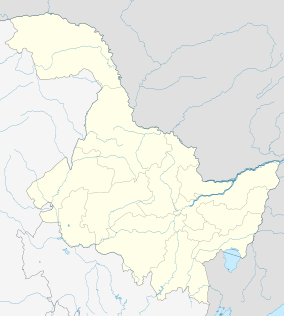Shuangyashan
| Shuangyashan 双鸭山市 | |
|---|---|
| Prefecture-level city | |
|
New Year's Parade in February 2002 | |
 Shuangyashan (red) in Heilongjiang (orange) | |
 Shuangyashan Location of the city centre in Heilongjiang | |
| Coordinates: 46°38′N 131°09′E / 46.633°N 131.150°E | |
| Country | People's Republic of China |
| Province | Heilongjiang |
| County-level divisions | 8 |
| Government | |
| • Type | Prefecture-level city |
| • CPC Shuangyashan Secretary | Li Xiangang (李显刚) |
| • Mayor | Wu Fengcheng (武凤呈) |
| Area | |
| • Total | 26,483 km2 (10,225 sq mi) |
| Population (2010)[1] | |
| • Total | 1,462,626 |
| Time zone | China Standard (UTC+8) |
| Postal code | 155000 |
| Area code(s) | 0469 |
| Licence plates | 黑J |
| ISO 3166-2 | cn-23-05 |
| Climate | Dwb |
| Shuangyashan | |||||||
|
"Shuangyashan", as written in Chinese | |||||||
| Chinese name | |||||||
|---|---|---|---|---|---|---|---|
| Simplified Chinese | 双鸭山 | ||||||
| Traditional Chinese | 雙鴨山 | ||||||
| Literal meaning | double duck mountain | ||||||
| |||||||
| Manchu name | |||||||
| Manchu script | ᠵᡠᡵᡠ ᠨᡳᠶᡝᡥᡝ ᠠᠯᡳᠨ | ||||||
| Russian name | |||||||
| Russian | Шуанъяшань | ||||||
Shuangyashan (Chinese: 双鸭山; pinyin: Shuāngyāshān) is a coal mining prefecture-level city located in the eastern part Heilongjiang province, People's Republic of China, bordering Russia's Khabarovsk and Primorsky krais to the east. The city's name means a pair-of-ducks mountains and refers to two peaks northeast of the city.[2] In 2007 it had a GDP of RMB 20.6 billion with a 14.2% growth rate.
Administrative divisions
 | ||||||
| # | Name | Hanzi | Hanyu Pinyin | Population (2003 est.) | Area (km²) | Density (/km²) |
|---|---|---|---|---|---|---|
| 1 | Jianshan District | 尖山区 | Jiānshān Qū | 210,000 | 118 | 1,780 |
| 2 | Lingdong District | 岭东区 | Lǐngdōng Qū | 90,000 | 908 | 99 |
| 3 | Sifangtai District | 四方台区 | Sìfāngtái Qū | 70,000 | 169 | 414 |
| 4 | Baoshan District | 宝山区 | Bǎoshān Qū | 130,000 | 572 | 227 |
| 5 | Jixian County | 集贤县 | Jíxián Xiàn | 310,000 | 2,860 | 108 |
| 6 | Youyi County | 友谊县 | Yǒuyì Xiàn | 120,000 | 1,800 | 67 |
| 7 | Baoqing County | 宝清县 | Bǎoqīng Xiàn | 420,000 | 13,443 | 31 |
| 8 | Raohe County | 饶河县 | Ráohé Xiàn | 140,000 | 6,613 | 21 |
History
Shuangyashan was given its name in AD 1384 during the Ming Dynasty. However, few people lived in the area before coal was discovered there in 1914. In 1928 a major coal mining operation was established on the site and in 1946 the area was first designated a county. Shuangyashan was established as a special mining district in 1954 and officially designated a city by the CPC Central Committee and State Council in 1956.
Geography and climate
Resources
Shuangyashan is rich in coal, magnetite and marble. The proven coal reserves in the city total 11 billion tons, ranking first out of 13 prefecture and prefecture-level cities in the province. The magnetite reserves in Shuangyashan exceed 120 million tons, ranking first in Heilongjiang Province.
Climate
The city has a cold temperate monsoon climate, with long, cold, windy winters. The average temperature in the city is about 3℃.
Economy
Shuangyashan is a major center for coal mining. The city also produces steel, lumber, chemicals, building materials, textiles, electric machinery, and food products. In 2010, Shuangyashan's GDP reached RMB 37.67 billion, featuring a growth of 25% from a year ago.[3] The production output of steel and coal ranked the first and the second in Heilongjiang province. The region has attracted investments from large domestic companies such as Shandong Luneng Group and Jianlong Group. Tourism, retailing and wholesaling are also the pillars of the city's service sector.[4]
More recently, the city has been feeling the effects of the coal downturn, with mining demand collapsing amidst a slowdown in China's economic growth.[5]
Transportation
Shuangyashan is the end of the Harbin to Shuangyashan railway spur link. 15 hours from Harbin by train, and 90 minutes from the closest prefecture-level city, Jiamusi. A modern freeway connects the town to Jiamusi over a distance of 57 km (35 mi). There is a modern coach service as well which does this trip in approximately 45 minutes. The city is 80 km (50 mi) from Jiamusi Airport, which operates regular flights to Beijing, Dalian, Shanghai, Qingdao, Guangzhou, Sanya and Khabarovsk.
Sight-seeing

Shuangyashan is surrounded by small mountains, and a large park based around one of these mountains forms a major feature of the outdoor life of the town. During the winter, this pine- and elm-covered mountain forms a lovely area for hiking and general snow play. In summer, the cool Heilongjiang summer, and the very long northern days make this a wonderful area to spend the days.

